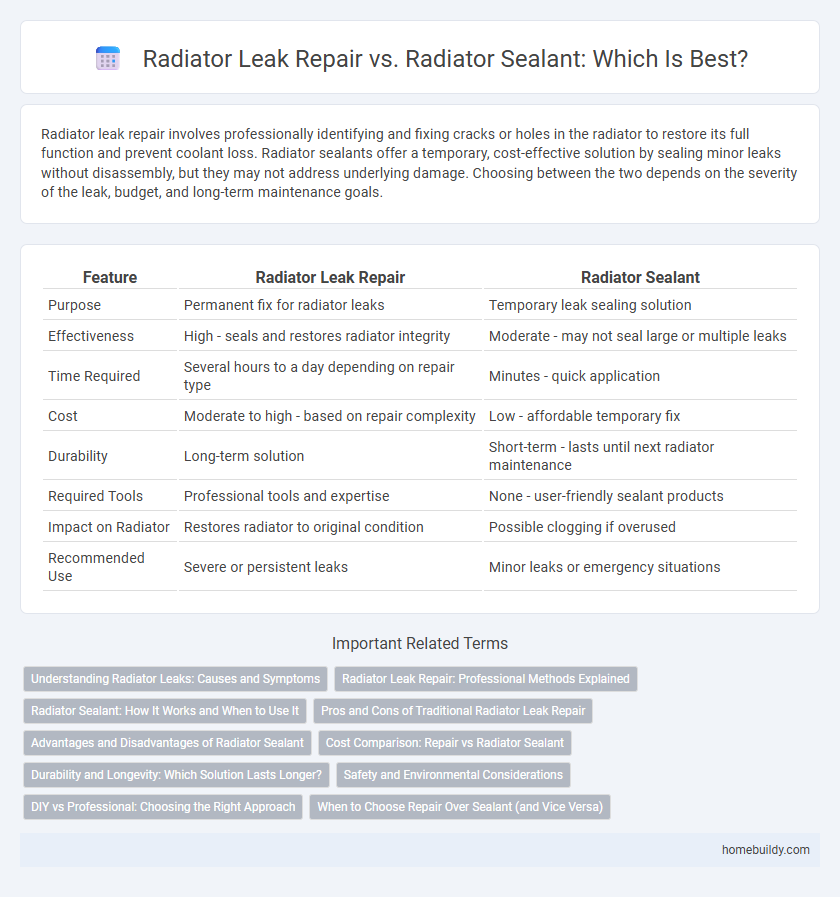Radiator leak repair involves professionally identifying and fixing cracks or holes in the radiator to restore its full function and prevent coolant loss. Radiator sealants offer a temporary, cost-effective solution by sealing minor leaks without disassembly, but they may not address underlying damage. Choosing between the two depends on the severity of the leak, budget, and long-term maintenance goals.
Table of Comparison
| Feature | Radiator Leak Repair | Radiator Sealant |
|---|---|---|
| Purpose | Permanent fix for radiator leaks | Temporary leak sealing solution |
| Effectiveness | High - seals and restores radiator integrity | Moderate - may not seal large or multiple leaks |
| Time Required | Several hours to a day depending on repair type | Minutes - quick application |
| Cost | Moderate to high - based on repair complexity | Low - affordable temporary fix |
| Durability | Long-term solution | Short-term - lasts until next radiator maintenance |
| Required Tools | Professional tools and expertise | None - user-friendly sealant products |
| Impact on Radiator | Restores radiator to original condition | Possible clogging if overused |
| Recommended Use | Severe or persistent leaks | Minor leaks or emergency situations |
Understanding Radiator Leaks: Causes and Symptoms
Radiator leaks commonly result from corrosion, physical damage, or faulty seals, which lead to coolant loss and engine overheating. Symptoms include visible coolant puddles, a drop in coolant levels, steam from the engine bay, and fluctuating temperature gauges. Identifying these signs early is critical for choosing between professional radiator leak repair or temporary fixes like radiator sealant.
Radiator Leak Repair: Professional Methods Explained
Radiator leak repair involves professional techniques such as pressure testing, welding, or replacing damaged radiator components to ensure a lasting fix and prevent coolant loss. Unlike radiator sealants, which offer a temporary and potentially corrosive solution, professional repairs address the root cause of leaks with precision and durability. Utilizing expert diagnostic tools and repair methods extends the radiator's lifespan and maintains optimal engine cooling performance.
Radiator Sealant: How It Works and When to Use It
Radiator sealant works by circulating through the cooling system and bonding to leaks or cracks to create a temporary or permanent seal, effectively stopping coolant loss. It is ideal for small leaks or minor cracks and offers a quick, cost-effective solution without the need for disassembly or professional repair. However, radiator sealant should be used as a temporary fix or as a preventive measure, as extensive leaks or damage require full radiator leak repair or replacement for long-term reliability.
Pros and Cons of Traditional Radiator Leak Repair
Traditional radiator leak repair provides a durable and permanent solution by replacing damaged components or welding cracks, ensuring the radiator maintains optimal cooling system performance. This method typically requires professional expertise and higher upfront costs but prevents potential engine overheating and long-term damage compared to temporary fixes. However, traditional repairs can be time-consuming and may involve invasive procedures that increase labor expenses and downtime for the vehicle.
Advantages and Disadvantages of Radiator Sealant
Radiator sealant offers a quick and cost-effective solution for minor radiator leaks, providing temporary relief without requiring a full system flush or part replacement. However, its disadvantages include potential clogging of radiator passages and reduced long-term effectiveness compared to professional radiator leak repair. While sealants can delay immediate repair costs, they often do not address underlying issues, leading to possible engine overheating or more expensive damage if used as a permanent fix.
Cost Comparison: Repair vs Radiator Sealant
Radiator leak repair typically costs between $150 and $900, depending on the severity and location of the leak, while radiator sealants are a budget-friendly alternative ranging from $10 to $30 per bottle. Although sealants offer a temporary fix and are less expensive upfront, professional repairs provide a long-term solution that prevents further engine damage and coolant loss. Choosing repair over sealant is cost-effective in the long run due to reduced risks of overheating and more extensive engine repairs.
Durability and Longevity: Which Solution Lasts Longer?
Radiator leak repair typically provides a more durable and long-lasting solution compared to radiator sealant, as professional repairs address the root cause by welding or replacing damaged components. Radiator sealants offer a temporary fix by sealing small cracks or leaks but may degrade over time due to heat and pressure fluctuations within the cooling system. For extended radiator lifespan and consistent performance, repair methods generally outperform sealants in ensuring long-term integrity and leak prevention.
Safety and Environmental Considerations
Radiator leak repair involves professional assessment and precise sealing methods that ensure long-term safety by preventing coolant loss and engine overheating, minimizing environmental impact through proper disposal of harmful fluids. Radiator sealants offer a quick fix by temporarily sealing leaks but may introduce chemical pollutants that can harm cooling systems and environment if misused. Choosing professional repair over sealants reduces risks associated with toxic chemicals, enhancing both vehicle safety and ecological responsibility.
DIY vs Professional: Choosing the Right Approach
Radiator leak repair often requires precise diagnosis and handling, with professional services providing thorough inspection and long-lasting fixes, especially for complex or significant damage. Radiator sealants offer a quick and temporary DIY solution by sealing small leaks without disassembling the system, but they may not address underlying issues or work on major cracks. Selecting between DIY sealant use and professional radiator repair depends on the leak size, vehicle age, and whether a permanent, reliable solution is needed.
When to Choose Repair Over Sealant (and Vice Versa)
Radiator leak repair is essential when dealing with large or multiple leaks, significant corrosion, or damage that compromises the radiator's structural integrity, ensuring a long-term fix. Radiator sealant is best suited for minor leaks or small cracks as a temporary solution to avoid immediate costly repairs or replacement. Choosing repair over sealant depends on the severity and location of the leak, vehicle age, and budget considerations for maintaining optimal cooling system performance.
Radiator Leak Repair vs Radiator Sealant Infographic

 homebuildy.com
homebuildy.com